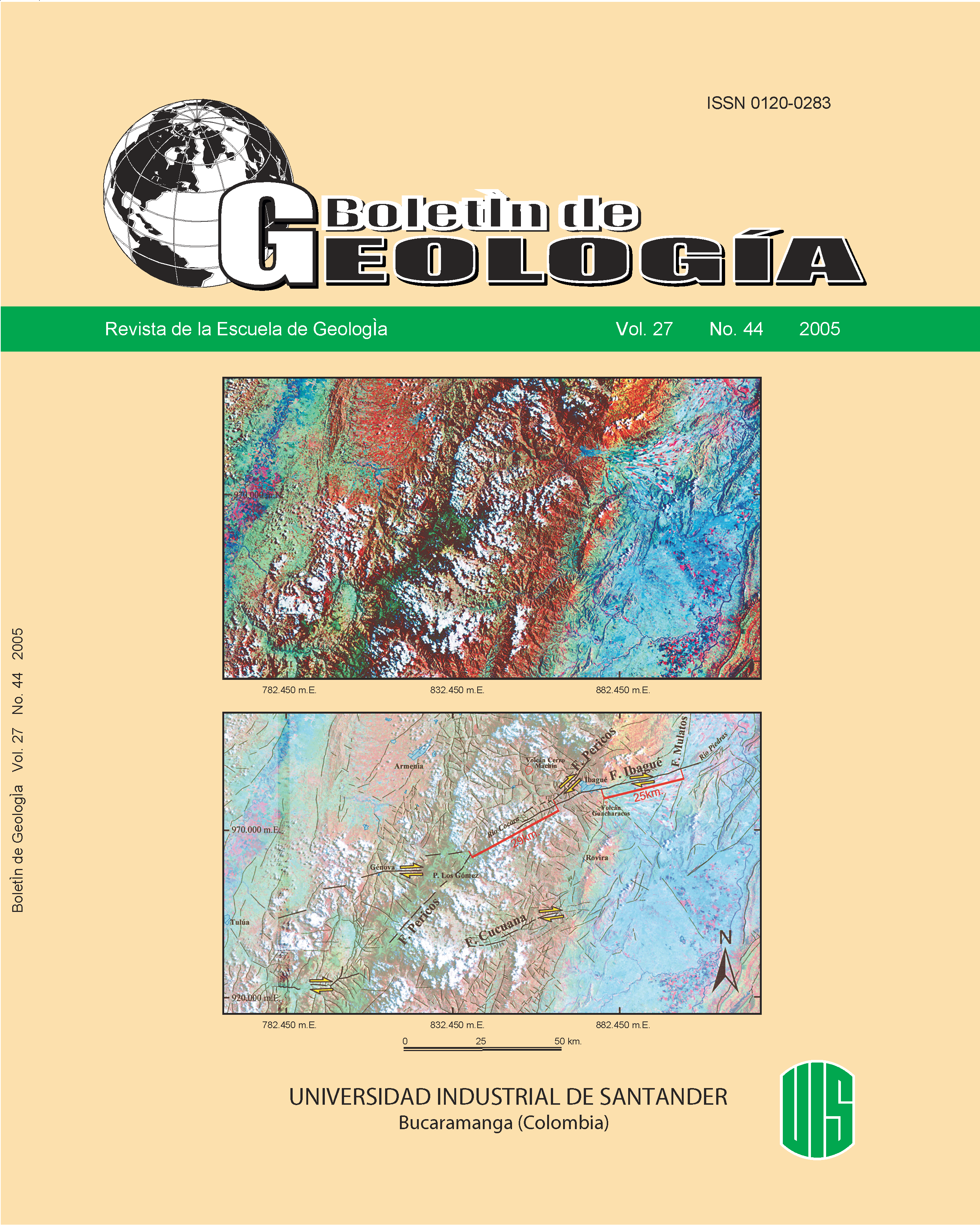Wrenching interpretation along the Boyaca and Soapaga faults from landsat TM images
Published 2005-01-11
Keywords
- Tectonic,
- wrenching,
- neotectonics,
- Eastern Cordillera,
- Colombia
How to Cite
Abstract
Identification of strike-slip faulting indicators, along the trace of the Soapaga and Boyacá faults from Landsat TM5 images, suggest a transpressive tectonic regime in the axial zone of the Eastern Cordillera of Colombia. The array of the Soapaga and Chaguacá faults conforms a duplex structure, which together with the Boyacá Fault indicate that the lateral left displacement, typical of the Bucaramanga Fault, continues up to an approximate latitude of 5º50’. Southwards of this latitude, some regional features indicate right-lateral displacements along the Soapaga and Boyacá faults and along the thrusts related to the Boyacá Fault. The continuity of the major NE longitudinal faults towards the Sabana de Bogota is suggested, as well as the existence of basement faults related to transverse lineaments, which extensional or transtensional movements can influence the seeping of hydrothermal fluids.
Downloads
References
Biddel, K., Christie-Blick, N. (editors). (1985). Strike-slipdeformation, basin formation, and sedimentation. Societyof Economic Palontologists and Mineralogistics. SpecialPublication, 37. Oklahoma
Boinet, T., Bourgois, J., Mendoza, H., Vargas, R. (1989).La Falla de Bucaramanga (Colombia): Su función durantela Orogenia Andina. Revista Norandina, Bogotá, Vol. 11,pp. 3-10
Butler, K., Schamel, S. (1988). Structure along eastern marginof the Central Cordillera, Upper Magdalena Valley, Colombia.Journal of South American Earth Sciences, Vol. 1 (1), pp.109-120
Carrillo, E., Vergara, H. (2001). Neotectónica y fallas activasdel nororiente colombiano. VIII Congreso Colombiano deGeología. Memorias. Manizales
Colletta, B., Hebrard, F., Letouzey, J., Werner, P.,Rudkiewicz, J. (1990). Tectonic style and crustal structureof the Eastern Cordillera (Colombia) from a balanced cross-section. In Letouzey, J., ed., Petroleum and tectonics inmobile belts: Paris, Editions Technip, pp. 81-100.
Cooper, M., Addison, F., Alvarez, R., Coral, M., Graham,R., Hayward, A., Howe, S., Martínez, J., Naar, J., Peñas,R., Pulham, J., Taborda, A. (1995). Basin developmentand tectonic history of the Llanos Basin, Eastern Cordillera,and Middle Magdalena Valley, Colombia. AAPG Bulletin,Vol. 79, No. 10, pp. 1421-1443.
Dengo, C., Covey, M. (1993). Structure of the EasternCordillera of Colombia: implications for trap styles and regionaltectonics. AAPG Bulletin, Vol. 77, No. 8, pp. 1315-1337
Ego, F., Sébrier, M., Lavenu, A., Yepes, H., Egues, A.(1996). Quaternary state of stress in the Northern Andesand the restraining bend model for the Ecuadorian Andes.Tectonophysics, Vol. 259, pp. 101-116.Fabre, A. (1983). La subsidencia de la Cuenca del Cocuy(Cordillera Oriental de Colombia) durante el Cretáceo y elTerciario. Segunda Parte: Esquema de evolución tectónica.Revista Norandina, Bogotá, No. 8, pp. 21-27.
Freitas de, M., Froncolin, J., Cobbold, P. (1997). TheStructure of the axial zone of the Cordillera Oriental,Colombia. VI Simposio Bolivariano “Exploración petroleraen las cuencas subandinas”. Memorias. Cartagena, TomoII, pp. 38-41
